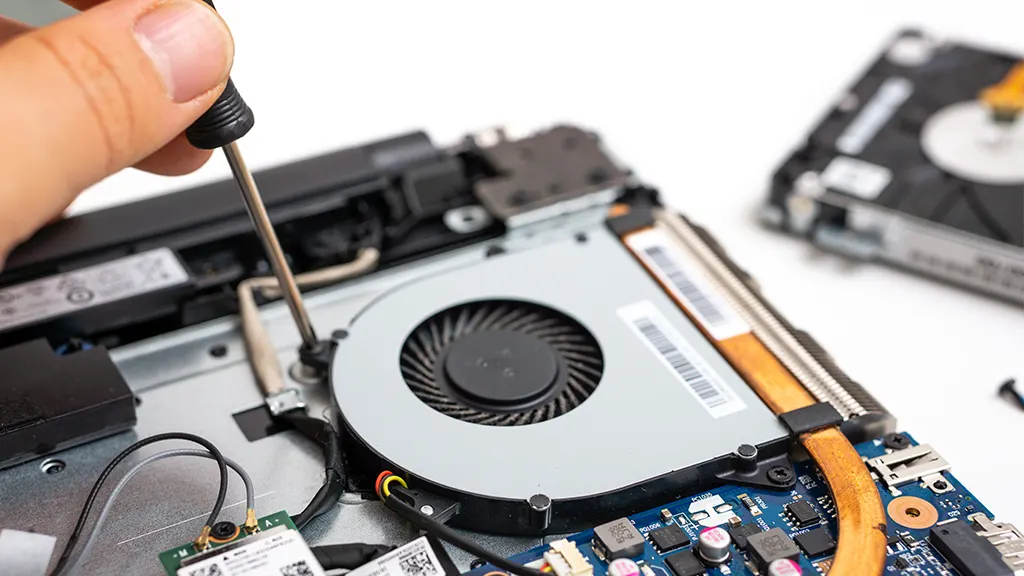How to fix a loud laptop fan

Whether you're in a meeting or at a quiet coffee shop, a loud laptop fan can be annoying—and embarrassing. But what can you do about it?
At Asurion, we help millions of people with their tech. From troubleshooting why your laptop won't connect to Wi-Fi to figuring out how much memory you'll need on your laptop, we keep the devices you rely on most working all day, every day. Here are our tips for fixing a loud laptop fan.
Why is my laptop fan so loud?
If your laptop fan is loud, screeching or making a grinding noise, it tends to be one of two things: Your device is overheating or something inside it—like the fan—is broken.
The first issue might even result in the second. A laptop that's working harder than it should creates excess heat and forces its fan to work overtime to cool it down. Overheating can cause your device to shut down or lead to permanent damage.
The good news is that there are a few simple steps that can help fix the problem:
- Put your laptop on a hard, flat surface.
- Clean the air vent
- Stop programs running in the background.
- Get rid of any viruses and malware.
- Reset your system management controller (SMC) and your parameter random access memory (PRAM).
- Update your drivers.

You can’t work when your computer doesn’t want to
Get it repaired fast at one of our stores. Just stop in or make an appointment⎯we'll handle the rest.
1. Put laptop on a hard, flat surface
Laptops let you work from anywhere and on any surface—even the stack of laundry you've been folding. But certain surfaces might block the vents that help your device cool down. Placing your laptop on a hard, flat surface keeps the fan vents from being blocked, allowing the internal fan to cool your machine down and get it working properly.
2. Clean the air vent
If your laptop is still loud or if the fan is constantly running, you should also check the air vents for dust, which might be clogging your device. To do so, aim a can of compressed air toward your laptop's fan vents at an angle, taking care not to spray air directly inside your machine. It's also a good idea to clean your laptop's vents every 6 months as a preventative measure, ensuring dust buildup won't cause your computer to overheat.
3. Stop programs running in the background
Laptops often run programs in the background while you're working in a different window. Those programs, as well as any windows you have open, can bog down your device. Here's how you can check to see if that's your issue:
To remove background programs for Mac:
- Launch Spotlight by pressing Cmd + Space, then search for “activity monitor".
- Open the Other folder.
- Click on the Activity Monitor icon.
- Double-click the process you wish to end. In the popup window that appears, click Quit.
To remove background programs for Windows:
- Launch the Task Manager by pressing Ctrl + Alt + Delete.
- Right-click the program you want to end.
- Click End Task.
4. Get rid of any viruses
A loud fan can indicate you've got a virus or other forms of malicious software on your laptop. Both can force your machine to work harder and cause its internal components to overheat. For help with hunting for and getting rid of computer viruses, check out our guide.
5. If using Mac, reset PRAM and SMC
If you have a MacBook®, your system management controller (SMC) and your parameter random access memory (PRAM), control, among other features and components, your laptop's internal fan. Resetting them may get your fan working properly. Here's how:
To reset PRAM:
- Shut down the laptop by going to the Apple® menu and clicking Shut Down.
- After your laptop shuts down, turn it on and immediately press and hold Option,+ Command + P + R together.
- You can release the keys after about 20 seconds after the laptop restarts.
To reset SMC:
- Connect the laptop to the charger and turn off the device.
- Press and hold Shift + Option + Control and the Power button at the same time for 30 seconds.
- Press the Power button to turn the laptop back on.
6. Update your drivers
Your laptop communicates with external devices like printers and headphones through a set of files called drivers. For your drivers to work properly, however, your software needs to be up to date.
To check for updates on Mac®:
- Click the Apple® menu in the corner of your screen, then click System Preferences.
- Click Software Update. If new software is found, click Update Now to install it.
To check for updates on Windows:
- Click the Start button on the Windows taskbar.
- Click the Settings icon.
- Select Updates & Security, then click Windows Update > Check for updates.
7. Find a replacement part
If the previous steps don't solve the problem, you may need a new fan or hard drive. Replacing either requires taking apart your laptop and putting it back together, so we recommend contacting a laptop repair expert for help so you don't do further damage to your device. Before you do so, however, make sure to back up your files.
If you've tried these steps and still need a little help, we're right around the corner. Schedule a repair at the nearest uBreakiFix® by Asurion store and our certified experts can get your device back up and running as soon as the same day.
The Asurion® trademarks and logos are the property of Asurion, LLC. All rights reserved. All other trademarks are the property of their respective owners. Asurion is not affiliated with, sponsored by, or endorsed by any of the respective owners of the other trademarks appearing herein.
- SHARE THIS ARTICLE